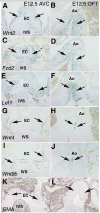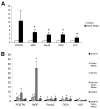Wnt signaling in heart valve development and osteogenic gene induction
- PMID: 19961844
- PMCID: PMC2814915
- DOI: 10.1016/j.ydbio.2009.11.030
Wnt signaling in heart valve development and osteogenic gene induction
Abstract
Wnt signaling mediated by beta-catenin has been implicated in early endocardial cushion development, but its roles in later stages of heart valve maturation and homeostasis have not been identified. Multiple Wnt ligands and pathway genes are differentially expressed during heart valve development. At E12.5, Wnt2 is expressed in cushion mesenchyme, whereas Wnt4 and Wnt9b are predominant in overlying endothelial cells. At E17.5, both Wnt3a and Wnt7b are expressed in the remodeling atrioventricular (AV) and semilunar valves. In addition, the TOPGAL Wnt reporter transgene is active throughout the developing AV and semilunar valves at E16.5, with more localized expression in the stratified valve leaflets after birth. In chicken embryo aortic valves, genes characteristic of osteogenic cell lineages including periostin, osteonectin, and Id2 are expressed specifically in the collagen-rich fibrosa layer at E14. Treatment of E14 aortic valve interstitial cells (VICs) in culture with osteogenic media results in increased expression of multiple genes associated with bone formation. Treatment of VIC with Wnt3a leads to nuclear localization of beta-catenin and induction of periostin and matrix gla protein but does not induce genes associated with later stages of osteogenesis. Together, these studies provide evidence for Wnt signaling as a regulator of endocardial cushion maturation as well as valve leaflet stratification, homeostasis, and pathogenesis.
Copyright 2009 Elsevier Inc. All rights reserved.
Figures








References
-
- Aikawa E, Nahrendorf M, Sosnovik D, Lok VM, Jaffer FA, Aikawa M, Weissleder R. Multimodality molecular imaging identifies proteolytic and osteogenic activities in early aortic valve disease. Circulation. 2007;115:377–386. - PubMed
-
- Aikawa E, Whittaker P, Farber M, Mendelson K, Padera RF, Aikawa M, Schoen FJ. Human semilunar cardiac valve remodeling by activated cells from fetus to adult. Circulation. 2006;113:1344–1352. - PubMed
-
- Barone LM, Owen TA, Tassinari MS, Bortell R, Stein GS, Lian JB. Developmental expression and hormonal regulation of the rat matrix Gla protein (MGP) gene in chondrogenesis and osteogenesis. J Cell Biochem. 1991;46:351–365. - PubMed
-
- Caira FC, Stock SR, Gleason TG, McGee EC, Huang J, Bonow RO, Spelsberg TC, McCarthy PM, Rahimtoola SH, Rajamannan NM. Human degenerative valve disease is associated with up-regulation of low-density lipoprotein-related protein 5 receptor-mediated bone formation. J Am Coll Cardiol. 2006;47:1707–1712. - PMC - PubMed
Publication types
MeSH terms
Substances
Grants and funding
LinkOut - more resources
Full Text Sources
Other Literature Sources
Molecular Biology Databases

